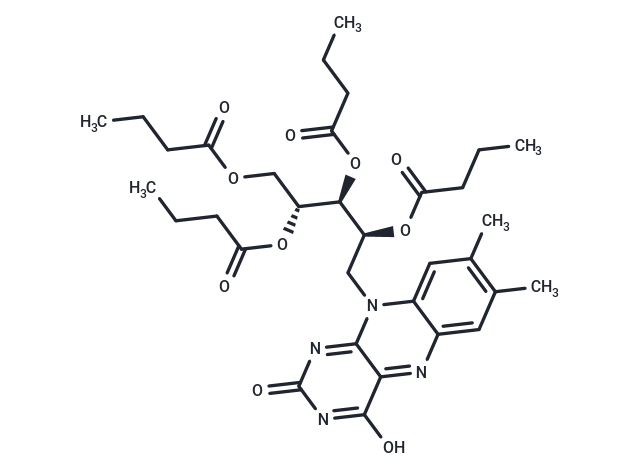Shopping Cart
- Remove All
 Your shopping cart is currently empty
Your shopping cart is currently empty

Riboflavin Tetrabutyrate, a lipophilic flavin derivative, possesses antioxidative and lipid peroxide-removing activities.

| Pack Size | Price | Availability | Quantity |
|---|---|---|---|
| 50 mg | $33 | In Stock | |
| 1 mL x 10 mM (in DMSO) | $50 | In Stock |
| Description | Riboflavin Tetrabutyrate, a lipophilic flavin derivative, possesses antioxidative and lipid peroxide-removing activities. |
| In vitro | Riboflavin Tetrabutyrate effectively suppresses NADPH-coupled and ascorbate-induced microsomal lipid peroxidation, also inhibiting oxygen uptake during such peroxidation. It appears to exert its antioxidative effects during or after the enzymic oxidation-reduction process, specifically after the abstraction of a hydrogen atom as a free radical from the active methylene group in polyunsaturated fatty acids[1]. |
| In vivo | Riboflavin Tetrabutyrate may enhance lipid metabolism in patients with atherosclerosis, diabetes, and fatty liver by inhibiting lipid peroxidation, resulting in decreased serum lipid levels. Prolonged administration increases hepatic 3-ketoacyl-CoA thiolase activity, promoting beta-oxidation of fatty acids in the liver, without affecting renal 3-ketoacyl-CoA thiolase, hepatic or renal acyl-CoA synthetase, and acyl-CoA dehydrogenase activities [1][2]. |
| Molecular Weight | 656.72 |
| Formula | C33H44N4O10 |
| Cas No. | 752-56-7 |
| Smiles | CCCC(=O)OC[C@@H](OC(=O)CCC)[C@@H](OC(=O)CCC)[C@H](Cn1c2cc(C)c(C)cc2nc2c(O)nc(=O)nc12)OC(=O)CCC |
| Relative Density. | 1.29g/cm3 |
| Storage | Powder: -20°C for 3 years | In solvent: -80°C for 1 year | Shipping with blue ice. | |||||||||||||||||||||||||||||||||||
| Solubility Information | DMSO: 100 mg/mL (152.27 mM), Sonication is recommended. | |||||||||||||||||||||||||||||||||||
Solution Preparation Table | ||||||||||||||||||||||||||||||||||||
DMSO
| ||||||||||||||||||||||||||||||||||||

Copyright © 2015-2025 TargetMol Chemicals Inc. All Rights Reserved.